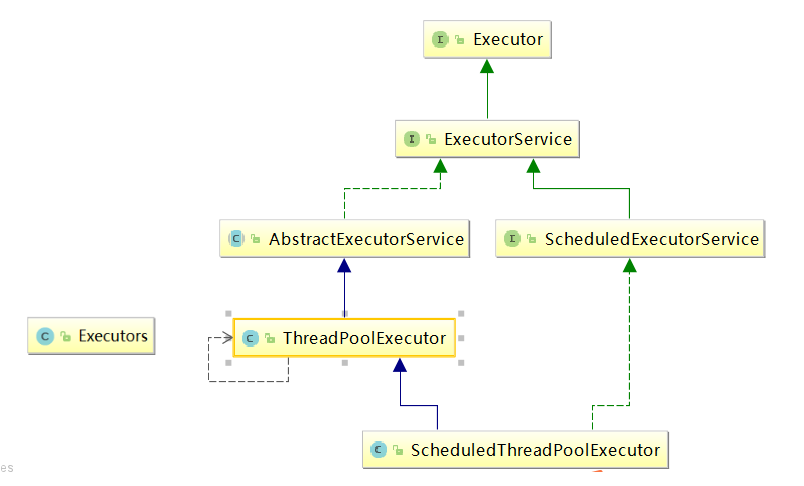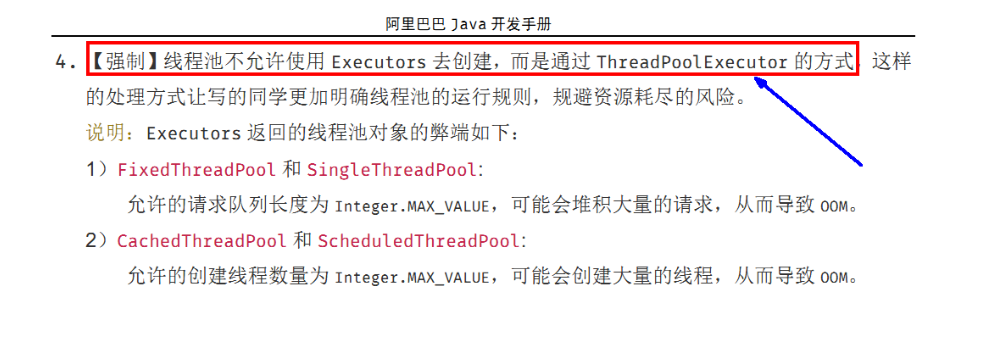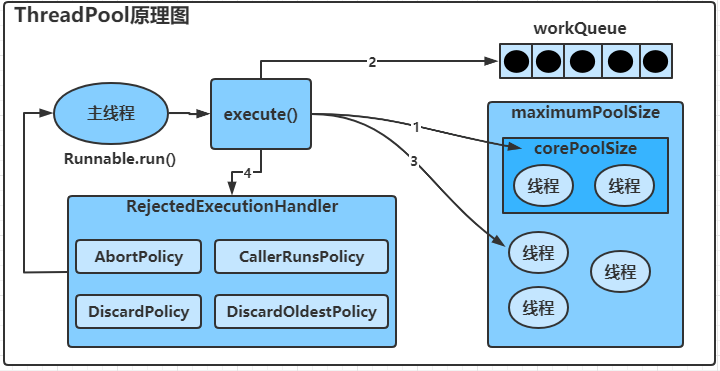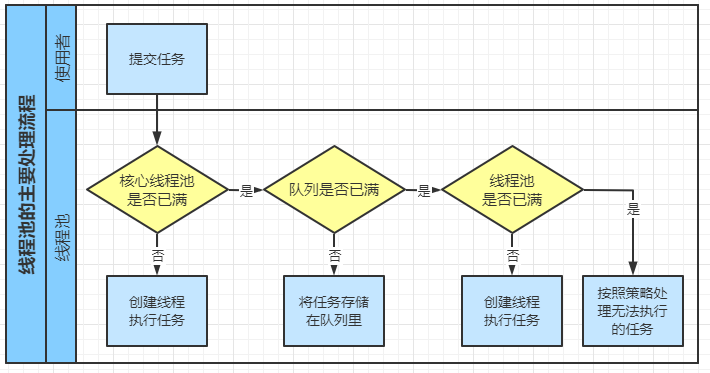1. ThreadPool线程池
1.1 线程池的使用
-
线程复用、控制最大并发数、管理线程
- 降低资源消耗。通过重复利用已创建的线程降低线程创建和销毁造成的销耗。
- 提高响应速度。当任务到达时,任务可以不需要等待线程创建就能立即执行。
- 提高线程的可管理性。线程是稀缺资源,如果无限制的创建,不仅会销耗系统资源,还会降低系统的稳定性,使用线程池可以进行统一的分配,调优和监控。
-
线程池架构

Executor,Executors,ExecutorService,ThreadPoolExecutor
1.1.1 三大方法
-
Executors.newFixedThreadPool(int)
- 执行长期任务性能好,创建一个线程池,一池有N个固定的线程,有固定线程数的线程
public static ExecutorService newFixedThreadPool(int nThreads) { return new ThreadPoolExecutor(nThreads, nThreads, 0L, TimeUnit.MILLISECONDS, new LinkedBlockingQueue<Runnable>()); }- newFixedThreadPool创建的线程池corePoolSize和maximumPoolSize值是相等的,它使用的是LinkedBlockingQueue
-
Executors.newSingleThreadExecutor()
- 一个任务一个任务的执行,一池一线程
public static ExecutorService newSingleThreadExecutor() { return new FinalizableDelegatedExecutorService (new ThreadPoolExecutor(1, 1, 0L, TimeUnit.MILLISECONDS, new LinkedBlockingQueue<Runnable>())); }- newSingleThreadExecutor 创建的线程池corePoolSize和maximumPoolSize值都是1,它使用的是LinkedBlockingQueue
-
Executors.newCachedThreadPool()
- 执行很多短期异步任务,线程池根据需要创建新线程,但在先前构建的线程可用时将重用它们。可扩容,遇强则强
public static ExecutorService newCachedThreadPool() { return new ThreadPoolExecutor(0, Integer.MAX_VALUE, 60L, TimeUnit.SECONDS, new SynchronousQueue<Runnable>()); }- newCachedThreadPool创建的线程池将corePoolSize设置为0,将maximumPoolSize设置为Integer.MAX_VALUE,它使用的是SynchronousQueue,也就是说来了任务就创建线程运行,当线程空闲超过60秒,就销毁线程。
-
从以上源码可以看出,三大方法底层均是使用ThreadPoolExecutor()来创建线程池
-
代码
import java.util.Arrays;
import java.util.List;
import java.util.concurrent.Executor;
import java.util.concurrent.ExecutorService;
import java.util.concurrent.Executors;
/**
* 线程池
* Arrays
* Collections
* Executors
*/
public class MyThreadPoolDemo {
public static void main(String[] args) {
//List list = new ArrayList();
//List list = Arrays.asList("a","b");
//固定数的线程池,一池五线程
//一个银行网点,5个受理业务的窗口
//ExecutorService threadPool = Executors.newFixedThreadPool(5);
//一个银行网点,1个受理业务的窗口
//ExecutorService threadPool = Executors.newSingleThreadExecutor();
//一个银行网点,可扩展受理业务的窗口
ExecutorService threadPool = Executors.newCachedThreadPool();
//10个顾客请求
try {
for (int i = 1; i <=10; i++) {
threadPool.execute(()->{
System.out.println(Thread.currentThread().getName()+" 办理业务");
});
}
} catch (Exception e) {
e.printStackTrace();
} finally {
threadPool.shutdown();
}
}
}
-
工作中均不使用以上三大方法来创建线程池,而是直接使用ThreadPoolExecutor()来创建线程池

public static void main(String[] args) {
ExecutorService threadPool = new ThreadPoolExecutor(
2,
5,
2L,
TimeUnit.SECONDS,
new ArrayBlockingQueue<Runnable>(3),
Executors.defaultThreadFactory(),
//new ThreadPoolExecutor.AbortPolicy()
//new ThreadPoolExecutor.CallerRunsPolicy()
//new ThreadPoolExecutor.DiscardOldestPolicy()
new ThreadPoolExecutor.DiscardOldestPolicy()
);
//10个顾客请求
try {
for (int i = 1; i <= 10; i++) {
threadPool.execute(() -> {
System.out.println(Thread.currentThread().getName() + " 办理业务");
});
}
} catch (Exception e) {
e.printStackTrace();
} finally {
threadPool.shutdown();
}
}
1.2 七大参数
- ThreadPoolExecutor()源码
/**
* Creates a new {@code ThreadPoolExecutor} with the given initial
* parameters.
*
* @param corePoolSize the number of threads to keep in the pool, even
* if they are idle, unless {@code allowCoreThreadTimeOut} is set
* @param maximumPoolSize the maximum number of threads to allow in the
* pool
* @param keepAliveTime when the number of threads is greater than
* the core, this is the maximum time that excess idle threads
* will wait for new tasks before terminating.
* @param unit the time unit for the {@code keepAliveTime} argument
* @param workQueue the queue to use for holding tasks before they are
* executed. This queue will hold only the {@code Runnable}
* tasks submitted by the {@code execute} method.
* @param threadFactory the factory to use when the executor
* creates a new thread
* @param handler the handler to use when execution is blocked
* because the thread bounds and queue capacities are reached
* @throws IllegalArgumentException if one of the following holds:<br>
* {@code corePoolSize < 0}<br>
* {@code keepAliveTime < 0}<br>
* {@code maximumPoolSize <= 0}<br>
* {@code maximumPoolSize < corePoolSize}
* @throws NullPointerException if {@code workQueue}
* or {@code threadFactory} or {@code handler} is null
*/
public ThreadPoolExecutor(int corePoolSize,
int maximumPoolSize,
long keepAliveTime,
TimeUnit unit,
BlockingQueue<Runnable> workQueue,
ThreadFactory threadFactory,
RejectedExecutionHandler handler) {
if (corePoolSize < 0 ||
maximumPoolSize <= 0 ||
maximumPoolSize < corePoolSize ||
keepAliveTime < 0)
throw new IllegalArgumentException();
if (workQueue == null || threadFactory == null || handler == null)
throw new NullPointerException();
this.acc = System.getSecurityManager() == null ?
null :
AccessController.getContext();
this.corePoolSize = corePoolSize;
this.maximumPoolSize = maximumPoolSize;
this.workQueue = workQueue;
this.keepAliveTime = unit.toNanos(keepAliveTime);
this.threadFactory = threadFactory;
this.handler = handler;
}
- 七大参数
- corePoolSize:线程池中的常驻核心线程数
- maximumPoolSize:线程池中能够容纳同时执行的最大线程数,此值必须大于等于1
- keepAliveTime:多余的空闲线程的存活时间,当前池中线程数量超过corePoolSize时,当空闲时间达到keepAliveTime时,多余线程会被销毁直到只剩下corePoolSize个线程为止
- unit:keepAliveTime的单位
- workQueue:任务队列,被提交但尚未被执行的任务
- threadFactory:表示生成线程池中工作线程的线程工厂,用于创建线程,一般默认的即可
- handler:拒绝策略,表示当队列满了,并且工作线程大于等于线程池的最大线程数(maximumPoolSize)时如何来拒绝请求执行的runnable的策略
1.3 四种拒绝策略
-
拒绝策略:等待队列已经排满了,再也塞不下新任务了,同时,线程池中的max线程也达到了,无法继续为新任务服务。这个是时候我们就需要拒绝策略机制合理的处理这个问题。
-
JDK内置四种拒绝策略

- AbortPolicy(默认):直接抛出RejectedExecutionException异常阻止系统正常运行
- CallerRunsPolicy:“调用者运行”一种调节机制,该策略既不会抛弃任务,也不会抛出异常,而是将某些任务回退到调用者,从而降低新任务的流量。
- DiscardOldestPolicy:抛弃队列中等待最久的任务,然后把当前任务加人队列中尝试再次提交当前任务。
- DiscardPolicy:该策略默默地丢弃无法处理的任务,不予任何处理也不抛出异常。如果允许任务丢失,这是最好的一种策略。
/** * new ThreadPoolExecutor.AbortPolicy() // 银行满了,还有人进来,不处理这个人的,抛出异 常 * new ThreadPoolExecutor.CallerRunsPolicy() // 哪来的去哪里! * new ThreadPoolExecutor.DiscardPolicy() //队列满了,丢掉任务,不会抛出异常! * new ThreadPoolExecutor.DiscardOldestPolicy() //队列满了,尝试去和最早的竞争,也不会抛出异常! */ -
以上内置拒绝策略均实现了RejectedExecutionHandle接口
1.4 线程池底层运行原理


-
在创建了线程池后,开始等待请求。
-
当调用execute()方法添加一个请求任务时,线程池会做出如下判断:
- 1如果正在运行的线程数量小于corePoolSize,那么马上创建线程运行这个任务;
- 2如果正在运行的线程数量大于或等于corePoolSize,那么将这个任务放入队列;
- 3如果这个时候队列满了且正在运行的线程数量还小于maximumPoolSize,那么还是要创建非核心线程立刻运行这个任务(队列中的依旧在等待);
- 4如果队列满了且正在运行的线程数量大于或等于maximumPoolSize,那么线程池会启动饱和拒绝策略来执行。
-
当一个线程完成任务时,它会从队列中取下一个任务来执行。
-
当一个线程无事可做超过一定的时间(keepAliveTime)时,线程会判断:
- 如果当前运行的线程数大于corePoolSize,那么这个线程就被停掉。所以线程池的所有任务完成后,它最终会收缩到corePoolSize的大小。
-
举例:
- 银行有5个窗口(maximumPoolSize),2个启用(corePoolSize),3个暂停服务,且等待区有5张椅子供等待使用(workQueue),开始时前面进来的2个客户直接到启用的2个窗口办理业务,后面来的客户,先到等待区椅子上等待,当等待区5张椅子坐满后,又有人进来办业务,于是银行就启用另外3个窗口进行服务,办理完业务的窗口,直接喊等待区的人去那个窗口办理,当5个窗口都在服务,且等待区也满的时候,银行只能让保安在门口堵着(RejectedExecutionHandler),拒绝后面的人员进入(毕竟疫情期间不能挤在一起嘛!!!)
import java.util.concurrent.*; /** * @Description TODO * @Package: juc.juc * @ClassName ThreadPoolDemo * @author: wuwb * @date: 2020/12/18 9:12 */ public class ThreadPoolDemo { public static void main(String[] args) { ExecutorService threadPool = new ThreadPoolExecutor( 2, 5, 2L, TimeUnit.SECONDS, new ArrayBlockingQueue<Runnable>(5), Executors.defaultThreadFactory(), new ThreadPoolExecutor.CallerRunsPolicy() ); try { for (int i = 1; i <= 10; i++) { final int j = i; threadPool.execute(()->{ System.out.println(Thread.currentThread().getName() + " run " + j); try { TimeUnit.SECONDS.sleep(2); } catch (InterruptedException e) { e.printStackTrace(); } }); } } catch (Exception e) { e.printStackTrace(); } finally { threadPool.shutdown(); } } } /* pool-1-thread-1 run 1 pool-1-thread-2 run 2 pool-1-thread-3 run 8 pool-1-thread-4 run 9 pool-1-thread-5 run 10 pool-1-thread-1 run 3 pool-1-thread-4 run 4 pool-1-thread-2 run 5 pool-1-thread-3 run 6 pool-1-thread-5 run 7 1、2进核心线程,3、4、5、6、7进队列等待,8、9、10启用非核心线程先于队列中任务运行 */*CPU密集型 最大线程数为CPU核数,CPU核数Runtime.getRuntime().availableProcessors();